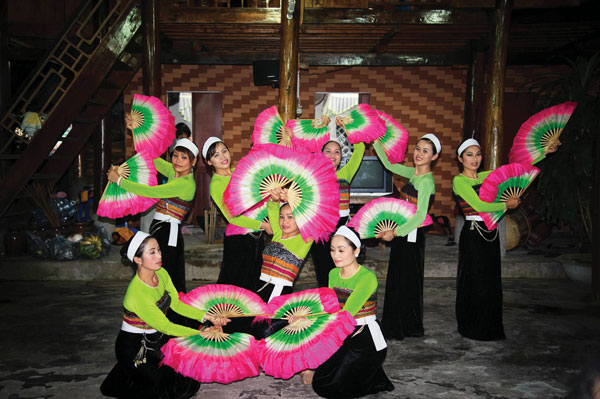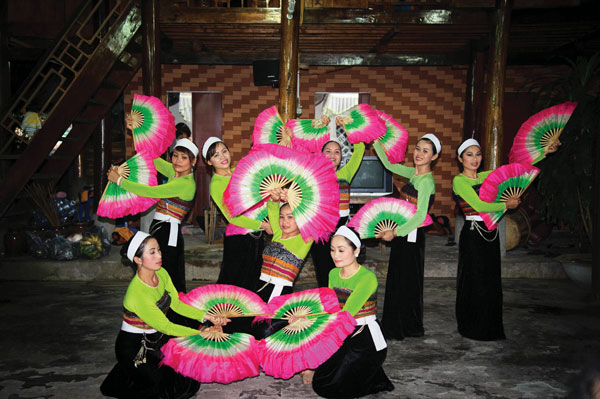(No.1, Vol.7,Feb-Mar 2017 Vietnam Heritage Magazine)

Xòe dance performed in Lac Village, Mai Chau Town, Hoa Binh Province, 2015.
Photo: Nguyen Ngoc Thai
The sensual rhythms of Thai xòe dancing perform a multitude of functions.
‘Without xòe there is no fun, rice yields no crop, maize shoots, no corn, girls and boys don’t make couples.’ Those are the words of an ancient song that Thai people sing to eulogize their xòe dance. Xòe is the Thai symbolic expression of love; love between a man and a woman, love of nature, love of native land, and love of hard work.
Thai people are an ethnic minority in Vietnam. Currently, there are 1,300,000 of them, living mostly in the northwest highlands. Thai culture is one of the most ancient and vibrant among about 20 ethnic groups that share the northwest mountains and forests.
The Northwest is a 5,500 ha highland region which includes 6 provinces and borders Laos and China. The terrain is rugged with high mountain ranges, most notably the 180km long and 30km wide Hoang Lien Son range, which has some over 3,000m high peaks.
Xòe is a folk dance, a priceless heritage of the Thai people that has a strong influence on other neighboring ethnic minorities.
Xòe has always been indispensable in Thai spiritual life. Every Thai person knows and loves the art of this dance. Xòe is performed every time Thai people celebrate something happy such as New Year’s, good harvest, festivals and wedding, and in rituals of faith.
Generations of Thai have passed down xòe from the 10th century by a tribal chief named Lac Truong. The 6 ancient forms of xòe, accompanied by the gourd instrument, two-string violin, drums, gongs and cymbals are the cream of the crop of Thai folk dances.
These 6 forms of xòe express different emotional tunes and tones. The ‘wine serving’ form shows refined hospitality and civility. The ‘pha xi’ form strengthens the unity of village communities. The boisterous ‘shawl throwing’ form expresses the infinite joy of a wedding, a new home built, or a good crop. The ‘don hon’ is a vow of unshakable love in spite of changes of heaven and earth and the hardships of life. ‘Kham khen’ form is the most fundamental of all Thai dances, inspired by the shared joys and hardships through the ups and downs of life. Finally, the ‘Om lom top mu’ finishes parties by expressing the happiness of gathering and sadness of parting.

Xòe dance performed during the ‘Muong Lo Cultural and Tourism Week’ in Nghia Lo Town, Yen Bai Province, 2016
Photo: Vu Dung
Upcoming events in which Thai people perform their xòe dance include the ‘Praying for Rain Festival’ on 11 March, 2017 at Moc Chau Dist, Son La Province, the ‘Mountain Ebony Festival’ from the 11 to 14 of March, 2017 at Dien Bien City, Dien Bien Province, and the ‘Devotion to Muong Festival’ on 2 March, 2017 at Moc Chau Dist, Son La Province.
Today, xòe has developed to include 36 forms to not only serve the Thai community and spiritual activities but also to perform on domestic and foreign stages. Xòe performers usually wear Thai traditional dress, very garish and unmistakable. The audience may include ritual attendees, festival or party goers, and the stage also changes accordingly. Thai people believe that xòe should bring a happy mood, and the more people that take part in a dance, the happier it becomes, the more the plants blossom, and the better the crop. So they often invite and draw tourists and party goers to dance together with them wherever they perform.
Thai xòe dance is said to be the thread of love that ties the northwestern highland minorities together.
If a ceremony takes place in an evening, xòe dances can continue until very late. The deeper the night, the livelier and the more vibrant xòe dances get. Sometimes boys and girls, hand in hand, smiles on their lips, eyes sinking into each other’s eyes, shake in the dance until the next morning.

